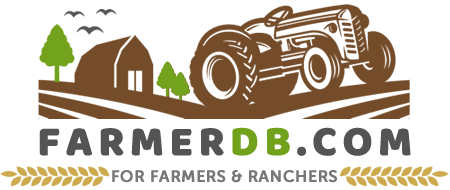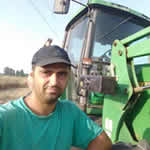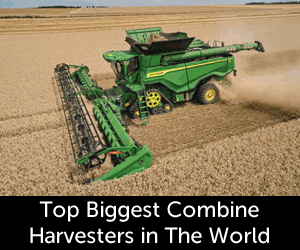The Shorthorn is a breed of domestic cattle that was first developed using Teeswater and Durham cattle, on the northeastern coast of England, in the counties of Northumberland, Durham, York, and Lincoln.
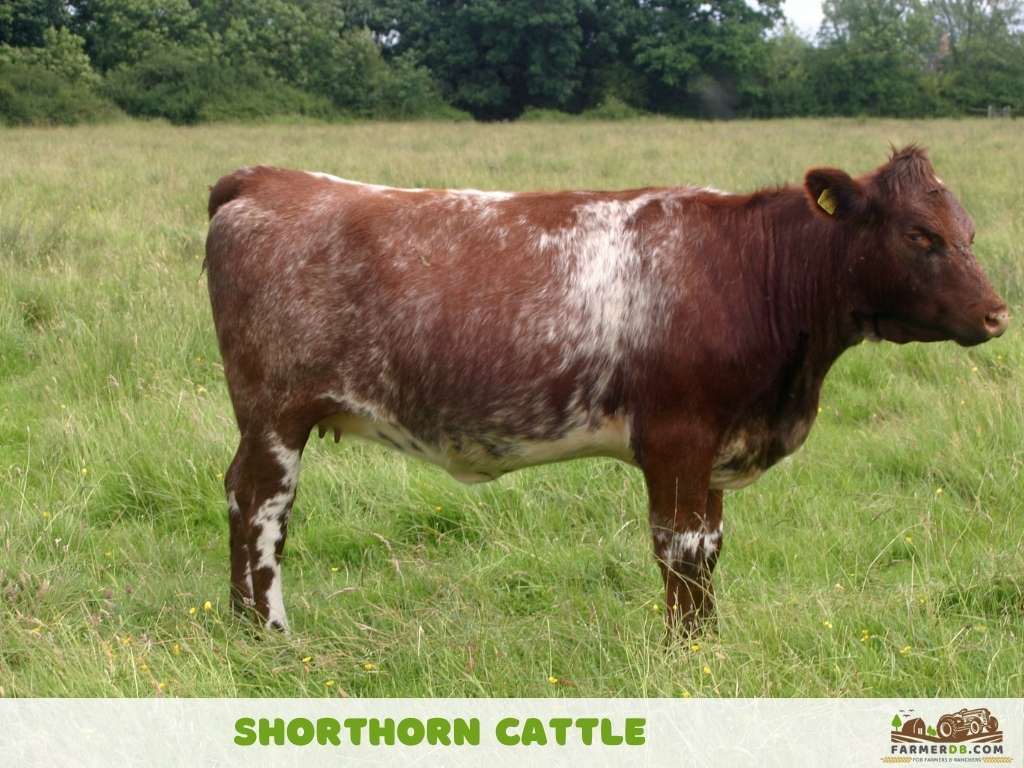
This breed has a long history, going through several crossbreeding efforts that focused on improving specific traits.
As a result, Shorthorn cattle have different strains, such as:
Beef Shorthorn: Used for meat production
Poll Shorthorn: Polled version of Beef Shorthorn
Milking or Dairy Shorthorn: Selective breeding for milk yield
Durnham: Originated for beef
Australian Shorthorn: Adapted for Australian conditions and used for meat production
Teeswater Shorthorn: Bred for both milk and meat production (dual-purpose)
This breed not only has multiple genetic components, but it has also contributed to the development of over 40 different cattle breeds worldwide, including Belmont Red and Santa Gertrudis.
Contents
Characteristics
Color
Shorthorn cattle come in a variety of colors and color patterns, such as the following:
1. White
White Shorthorns are completely white or sometimes have small light cream areas. They stand out with their clean, pure white coats, and their skin is usually pale.
These cattle may have some red hairs around their nostrils, eye sockets, and in their ears. This color variation is one of the rarer ones in the breed.
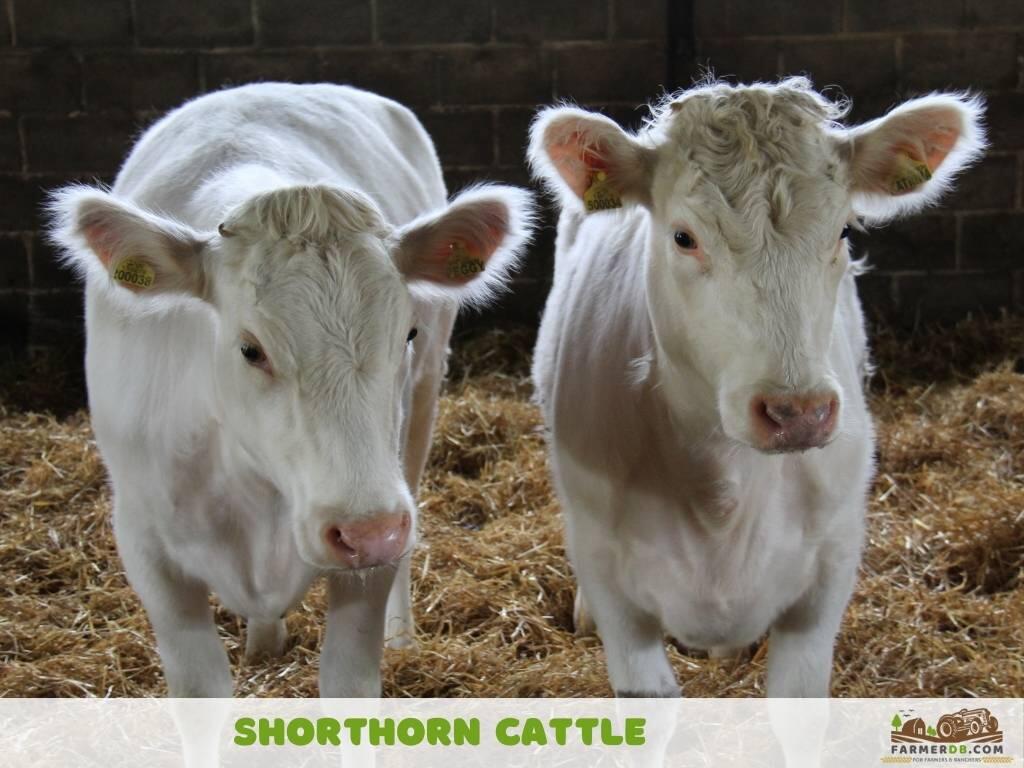
2. Red and White
These cattle feature a combination of red and white, with the colors appearing in patches across their bodies. They are usually at least 30% red or white, with the remaining percentage being the opposite color.
3. Roan
These cattle have red coats with white. These white markings may appear as smaller patches or spots on the legs, face, or underbelly.
4. Red and White marks
Roan Shorthorns have a mix of red and white hairs, which gives them a mottled or spotted look. This creates a blended effect, with the red and white hairs spread evenly, making the coat look lighter or frosted.
Depending on the balance of red and white, Roan Shorthorns may appear more white or more red.
5. Red
Red Shorthorns have a solid red coat, which can vary from a light red to a deep, dark red.
Head
Males have a strong, masculine head with a broad muzzle, while females have a more feminine head with bright, clear, and alert eyes and a wide muzzle. The teeth in both sexes make good contact with the palate, without any signs of an undershot or overshot jaw.
Horns
This breed can be horned or polled.
The polled version is specifically called the Polled Shorthorn, while the horned version has medium-sized horns that are curved or slightly twisted.
Male Body
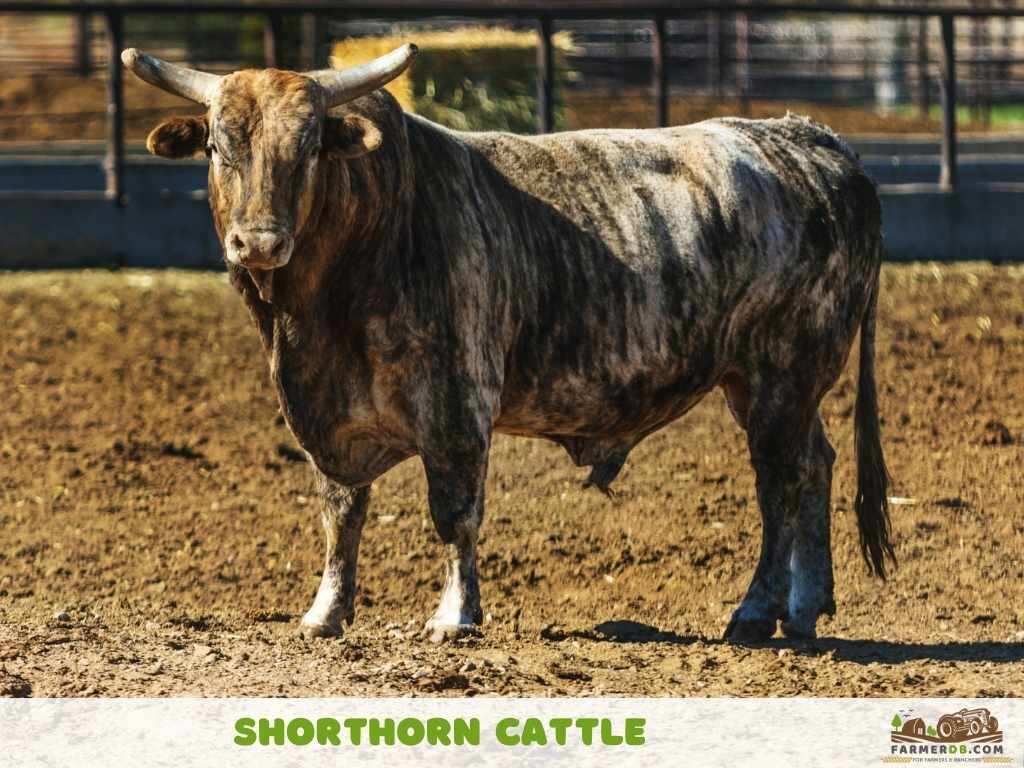
Bulls have a deep body with a good spring of rib, providing ample rumen capacity. The rump is long, wide, and square on top, with a slight slope from the hooks to the pins. The thighs are wide and well-muscled, with the second thigh well-rounded and the flank deep and full.
The testicles are uniform in size and consistency, with a circumference of at least:
- 12.6 in (32 cm) for bulls aged 12-18 months
- 13.4 in (34 cm) for bulls aged 18-24 months
- 13.8 in (35 cm) for bulls older than 24 months
The legs show a slight angle at the hock and pasterns, but are not too straight or too curved.
Female Body
The female body has a top line that is long and straight from the shoulders to the hook bones, with a slight slope from the hook bones to the pin bones, providing enough width between the pin bones for easy calving.
From the plates, there is a natural width with firm muscles on the first thigh, which continues down to a deep second thigh and a level flank. The udder attachment is good, and the teats are medium-sized and placed squarely.
Size
These cattle are considered to be of medium to large size.
As for measurements:
The Beef Shorthorn bull has a height of 59 in (150 cm), and the female can grow up to 55 in (140 cm).
The Dairy Shorthorn bull has a height of 56 in (143 cm), and females range from 54 to 55 in (137 to 140 cm).
The White Shorthorn has the same measurements as the Dairy Shorthorn, with bulls at 56 inches (143 cm) and females at 54 to 55 in (137 to 140 cm).
Lifespan
The Shorthorn cattle raised for beef have an average lifespan of 15 to 20 years.
In contrast, the Milking or Dairy Shorthorns can live longer than 20 years with good nutrition. There are many stories where these cattle were still very productive at 15-18 years old.
Growth Rate
How fast do they grow?
The Beef and Poll Shorthorns, which are used for meat production, have a fast growth rate.
An average daily gain for these cattle is around 2.25 lbs (1.02 kg), though some have achieved even higher gains. For example, a herd in the UK managed to achieve an average daily gain of 2.5 lbs (1.12 kg) up to 400 days in its heifers, under a forage-based system.
In a 1996 study analyzing 4,594 steers, Shorthorns had the highest average daily gain in both the backgrounding and feedlot phases.
Weight
The Beef and Poll Shorthorn bulls weigh 2,469 lbs (1,120 kg), while the females weigh around 1,543 lbs (700 kg). Their average birth weight is about 88 lbs (40 kg).
The Dairy Shorthorn male weighs 2,182 lbs (990 kg), and the female weighs 1,485 lbs (675 kg). The Teeswater Shorthorn, or the British Shorthorn version, has a weight range of 1,433 to 1,500 lbs (650 to 680 kg) for females.
For the Australian Shorthorn, mature bulls with old bloodlines average around 1,760 lbs (800 kg), while mature cows go up to 1,100 lbs (500 kg).
Feed Conversion Ratio
This breed is very good at turning food into weight.
According to three US feedlots with 11 years of data, these cattle had a feed conversion ratio (FCR) of 5.22:1, meaning they needed 11.5 lbs (5.22 kg) of feed to gain 2.2 lbs (1 kg) of weight.
In another study, the FCR was 5.58:1, meaning the cattle required 12.3 lbs (5.58 kg) of feed to gain 2.2 lbs (1 kg) of weight. This was slightly more than the previous study but still better than many other cattle breeds.
Overall, Shorthorns perform well in feed efficiency, which means lower feed costs and higher profits for farmers.
Slaughtered Time
The optimal age for slaughtering beef cattle is typically between 18 to 24 months, although this can vary depending on factors like meat quality, market demands, and feeding practices.
At this age, the cattle generally weigh between 1,100 to 1,300 lbs (500 to 590 kg).
Their dressing percentage is around 55%, which means that for a beef cattle weighing between 1,100 to 1,300 lbs (500 to 590 kg), the carcass weight would range from 605 to 715 lbs (274 to 325 kg).
Temperament
Their temperament is calm, docile, and stable. They can be easily raised because they don’t show signs of aggression in their character.
Their gentle temperament allows for smoother management in both dairy and beef operations, and they adapt well to various farming environments. Because of their friendly disposition, even those new to raising cattle can confidently raise Shorthorns with ease.
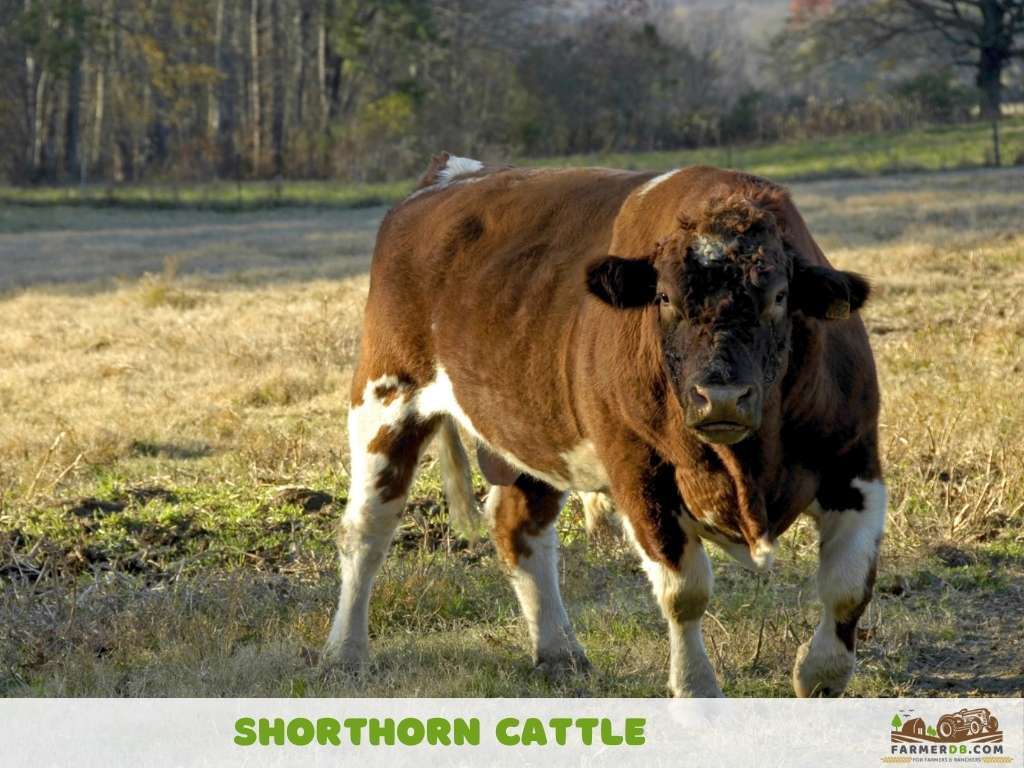
Meat
The data shows that Shorthorn cattle outperform others in terms of beef quality, boasting the highest USDA Choice percentage and a strong Yield Grade. With a 2.1 yield grade, Shorthorn is ahead of breeds like Charolais, Gelbvieh, and Hereford/Angus, offering more lean meat per carcass.
In other important areas, these cattle also perform well in fat cover (less fat), calculated yield grade (more lean meat), and retail product yield (more cuts of meat).
Although Angus has a higher USDA quality grade, Shorthorn still leads in carcass yield and retail product percentage, making it a strong choice for beef production.
| Breed | Fat Cover | USDA Quality Grade | Calculated Yield Grade | % Retail Product Yield | Breed Placing |
|---|---|---|---|---|---|
| Shorthorn | 0.485 | Low Choice | 2.6 | 64.37% | 1 |
| Hereford | 0.580 | Low Choice | 2.8 | 63.43% | 2 |
| Red Angus | 0.598 | Low Choice | 2.9 | 63.13% | 3 |
| Angus | 0.639 | Avg Choice | 3.0 | 62.89% | 4 |
Beyond the numbers, Shorthorn beef is known for its nice red color and is often described as tender, with a milder flavor compared to other beef breeds.
Milk
Milking Shorthorns are efficient milk producers, yielding around 1,794 gallons (6,796 l) of milk during a 305-day lactation.
The milk has a protein content of about 3.3% and butterfat content of 3.8%.
Did you know? In 1924, Melba 15th of Darbalara, a Milking Shorthorn cow, set the World Production Butterfat record by producing 3,781 gallons of milk (14,315 l) and 1,614 lbs (732 kg) of butterfat in just 365 days.
Raising
Feeding
These cattle are adaptable to all types of diets, including grass-fed, grain-fed, or grain-finishing.
If you choose to raise them grass-fed, you’ll need to provide them with grass, pasture, and forage like hay or silage during the colder months when fresh grass isn’t available. During the grazing season, they can also eat alfalfa, clover, and other legumes.
However, when raising them on a forage-based diet only, you should expect slower growth compared to those fed grains. But in the end, the beef produced will be leaner and known for having a more natural flavor.
If you decide on a grain-fed approach, you can allow them to partially graze on forage and supplement with a mix of grains like corn, soybean meal, barley, or oats. Grains will speed up their growth rates, but they’ll also lead to a higher fat cover on the meat, which results in more marbling. The marbling makes the beef tender and juicier.
The last option is grain-finishing, which involves feeding them grain-based diets (like corn or barley) towards the end of their growth period. Grain-finishing increases the tenderness and marbling of the meat, giving it a richer flavor and making it more juicy.
Don’t forget to offer them a fresh water source and make sure they have enough to drink every day.
Climate and Shelter
Shorthorn cattle can live in many climates, from cold regions with snow to hot areas with dry summers.
They are strong animals and can handle different weather conditions, but they do best when they have good food and water.
In very cold places, they grow a thicker coat to stay warm, and in hot climates, they do well as long as they have shade and enough water.
Shelter is important in extreme weather. In winter, windbreaks or barns help them stay warm, while in summer, trees, open sheds, or artificial shade protect them from the sun.
Fencing needs to be strong enough to keep them inside and safe from predators. Wooden fences, wire fences, or electric fences all work well as long as they are high and strong enough.
How many acres per head of cattle?
4 to 5 acres per cattle is enough for proper growth and development, but this amount is needed only for a grass-fed diet on rich pasture.
If you choose to supplement feed with grains, then the land requirement will decrease.
In case of low vegetation, even with supplemental feed, you may still need the same amount of land as with rich pasture.
The exact number of acres needed depends on pasture quality, feed management, and overall farm conditions. It’s also important to monitor the health and weight of the animal.
If the cattle aren’t gaining enough weight or maintaining their condition, it means they aren’t getting enough nutrition, and something needs to be adjusted, either increasing available land or modifying the diet with additional feed.
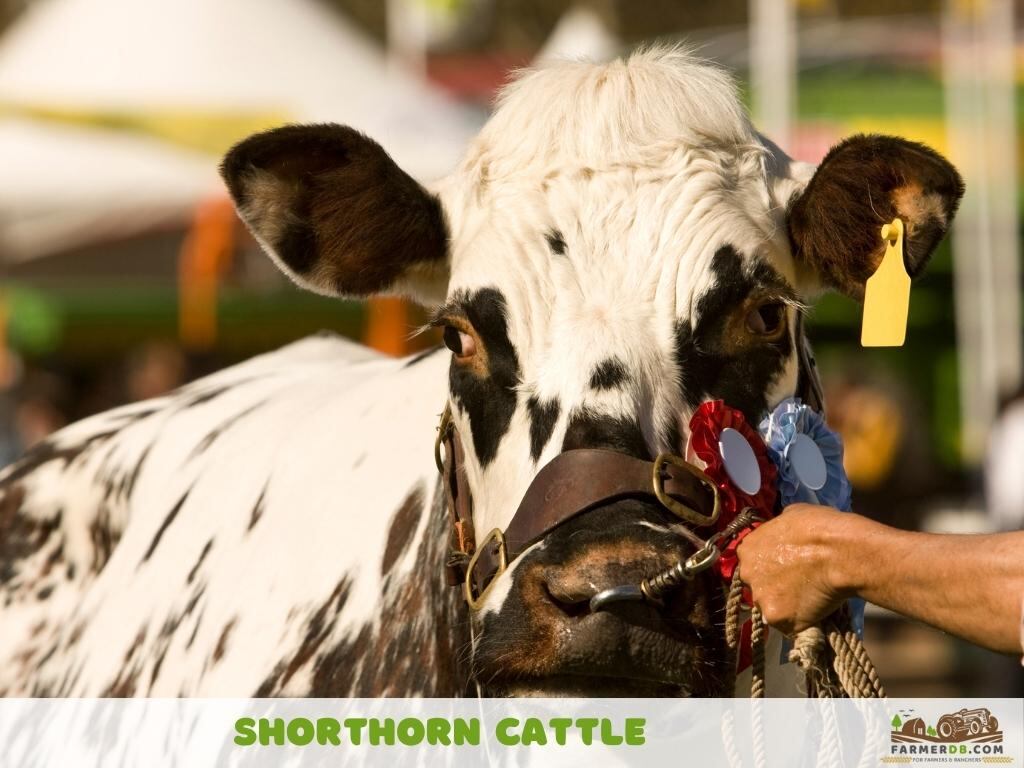
Breeding
Breeding can start quite early for this type of cattle, with heifers from 15 months old and bulls from 12 to 15 months old.
For breeding methods, natural mating is the most commonly used for this breed, followed by artificial insemination (AI), which is preferred by farmers looking to improve the genetics of their herd even further.
The fertility rate is high, and mature bulls can mate with up to 50 cows, while younger bulls typically handle 15 to 25 cows per breeding season.
Calving ease is very good, with research showing that in 98% of cases, these cattle do not need assistance during birth. Along with easy calving, calf survival rates are also very high.
Older Shorthorn cows continue to produce calves efficiently even past 10 years of age.
Mothers have a strong instinct for caring for their offspring, and their milk production is sufficient to provide good nutrition until weaning.
If needed, here is a Cattle Gestation Calculator
Terminal vs. Maternal
These cattle can be used in both terminal and maternal roles. In terminal breeding programs, they help improve meat quality and growth rate of the cattle. As maternal animals, they offer good care for their offspring, along with good fertility and ease of calving.
Health Issues
This cattle breed has some genetic conditions that require attention, as the association encourages testing for them, as some can be fatal. Some of these include Tibial Hemimelia (TH) (see refs.), Pulmonary Hypoplasia with Anasarca (PHA) (see refs.), and Digital Subluxation (DS) (see refs.).
Advantages
- Longevity
- Good temperament
- Feed efficiency
- Carcass quality
- Fertility
- Calving ease
- Maternal efficiency
- Good growth rate
Disadvantages
- Prone to genetic mutations
- Less muscular than some beef breeeds
- Not ideal for intensive dairy farming
- Genetic variation in performance. Some bloodlines may perform better than others.
History and Origins
Some people say that the development of this breed began as early as 1580 in North England, but some records suggest that cattle breeding practices didn’t start until around 1750.
Between 1730 and 1780, famous breeders like Sharter, Pickering, and Stephenson worked to improve the quality and size of the cattle. These breeders recorded their cattle in the first English Herd Book, which was published in 1822.
In 1783, Charles Colling discovered four key cows: Duchess, Cherry, Strawberry, and Old Favourite, while his brother Robert Colling bought a bull named Hubback for £8. These bloodlines led to the birth of the bull Comet in 1804, which later sold for 1,000 guineas in 1810, the highest price ever for a bull at that time.
At the same time, breeders like Thomas Bates and John Booth were also improving the Teeswater cattle. Bates focused on better milk production, while Booth worked on improving beef quality. Both believed in inbreeding or line breeding to enhance the cattle.
In 1822, George Coates published the first herd book with records of Shorthorn cattle, making it the world’s first pedigree herd book. In 1874, the Shorthorn Society of Great Britain and Ireland was formed, and they took over the publishing of the herd book.
During the 20th century, Shorthorn cattle were used for both milk and beef. However, as breeders began to specialize in either beef or milk, the herd book was split into two sections in 1958. Beef breeders developed the Beef Shorthorn breed, and in 1970, the dairy breeders focused on improving the dairy characteristics of the breed.
References
- Heritage Shorthorn Society link
- A Feedlot Sire Evaluation Scheme to improve the commercial competitiveness of Australian Grain Fed Beef link
- Health Issues link
Do you have any experience with the topic discussed here?
Would you like to improve the information shared and contribute your practical knowledge on the subject?
Your real-world experience as a farmer or rancher could greatly benefit other members, and the community would deeply appreciate your contribution.
